-
×
 Children's swimwear - SW01 2/12 BG long sleeve 1 × $648.00
Children's swimwear - SW01 2/12 BG long sleeve 1 × $648.00 -
×
 Newborn chiffon dress 6m/36m 1 × $1,112.00
Newborn chiffon dress 6m/36m 1 × $1,112.00 -
×
 Puffy newborn dress 6/36month 1 × $652.00
Puffy newborn dress 6/36month 1 × $652.00 -
×
 Boys and girls cotton down jacket, size 2/10 years old 1 × $1,265.00
Boys and girls cotton down jacket, size 2/10 years old 1 × $1,265.00
News
The Best Fabrics for Kids: Safe, Soft, and Gentle on Sensitive Skin
Introduction
When it comes to kids’ clothes, most parents think first about how cute an outfit looks or how practical it will be for daily life. But underneath the style and the colors, there’s something even more important: the fabric.
Children’s skin is far more delicate than adult skin. It’s thinner, more sensitive, and more prone to irritation. A fabric that feels fine to you might be scratchy or even harmful for your child. That’s why choosing the right fabric isn’t just about comfort—it’s about health, safety, and happiness.
Imagine dressing your baby in a stiff polyester onesie. Within minutes, their skin might feel clammy. Or think of your toddler running around in a shirt that doesn’t breathe well. They’ll overheat and end up cranky. Now picture your child wearing soft, breathable cotton or bamboo fabric. They stay comfortable, dry, and free to move. That difference can set the tone for the whole day.
In this guide, we’ll explore the best fabrics for kids—what makes them safe, what makes them comfortable, and why they matter. From everyday cotton to luxurious merino wool, we’ll go over the top choices for different seasons and needs. We’ll also talk about fabrics you might want to avoid, plus practical tips for parents to make shopping easier.
Because at the end of the day, clothes aren’t just about how your child looks. They’re about how your child feels. And every child deserves to feel cozy, happy, and safe in their own skin.
What Makes a Fabric “Kid-Friendly”?
Before diving into specific fabrics, it helps to understand what actually makes a fabric good for kids. Parents often hear buzzwords like “organic,” “natural,” or “breathable,” but what do these really mean? Let’s break it down.
Softness
Kids’ skin is extremely sensitive. Fabrics that feel rough or scratchy can cause rashes or discomfort. A kid-friendly fabric should feel soft to the touch, smooth against the skin, and flexible enough to move with the child.
Breathability
Children sweat more easily than adults, especially when running around. Breathable fabrics allow air to circulate and moisture to escape, keeping them cool and comfortable. Fabrics that trap heat or moisture can lead to irritation and overheating.
Absorbency
Accidents, spills, and sweat are part of childhood. Good fabrics for kids can absorb moisture without feeling soggy or sticky. This helps prevent skin irritation and keeps kids feeling fresh.
Safety
Some fabrics are treated with harsh chemicals, dyes, or finishes that can irritate skin. A kid-friendly fabric should be free from harmful substances. Certifications like OEKO-TEX Standard 100 are a good sign that a fabric is safe.
Durability
Kids are rough on clothes. They crawl, climb, spill, and play hard. Fabrics for children should be able to handle frequent washing and heavy use without falling apart.
Natural vs. Synthetic
In general, natural fabrics (like cotton, bamboo, and wool) are better for children because they are breathable, soft, and less likely to cause irritation. Synthetic fabrics (like polyester or nylon) may be cheaper and durable, but they often trap heat and moisture.
When you keep these qualities in mind, shopping becomes easier. Instead of just looking at cute designs, you’ll know how to pick clothes that truly support your child’s comfort and well-being.
Cotton: The Everyday Hero
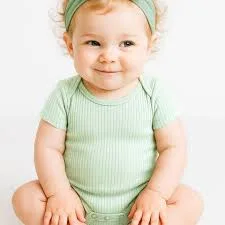
If there’s one fabric that parents around the world rely on, it’s cotton. From baby onesies to school uniforms, cotton is everywhere. And there’s a good reason for that: it’s one of the most kid-friendly fabrics available.
Why Cotton Works So Well
Softness: Cotton feels gentle on the skin, making it perfect for newborns and toddlers.
Breathability: It allows air to flow, which keeps kids cool in warm weather.
Moisture Absorbency: Cotton can soak up sweat and spills without feeling heavy.
Easy Care: Cotton clothes can usually go straight into the washing machine and come out fine.
Organic Cotton vs. Regular Cotton
Regular cotton is widely available, but it’s often grown with pesticides and treated with chemicals. Organic cotton, on the other hand, is grown without harmful chemicals and is processed more gently. It’s safer for sensitive skin and better for the environment. Parents who want peace of mind often choose organic cotton, especially for baby clothes and sleepwear.
Everyday Uses
Cotton is versatile. It can be used in:
Onesies and bodysuits
T-shirts and tops
Dresses and skirts
Pajamas
School uniforms
Downsides of Cotton
Cotton isn’t perfect. It wrinkles easily, and some cotton garments shrink after washing if not pre-shrunk. In very hot weather, cotton can hold onto moisture, which may leave the fabric feeling damp. But overall, these are small trade-offs compared to its benefits.
Cotton is the “everyday hero” because it works for almost every situation. Whether it’s playtime, naptime, or school, cotton keeps kids comfortable without breaking the bank.
Organic Cotton: A Step Up
While regular cotton is good, organic cotton takes things to another level. Parents today are more conscious of what touches their children’s skin, and organic cotton has become a favorite for that reason.
Why Choose Organic Cotton?
No Harsh Chemicals: It’s grown without pesticides and processed without toxic dyes or bleaches.
Gentle on Skin: It’s less likely to cause allergic reactions or irritation.
Eco-Friendly: Organic cotton farming uses less water and avoids harmful chemicals, making it better for the planet.
When to Choose Organic Cotton
Baby essentials like onesies, blankets, and pajamas.
Kids with sensitive skin or eczema.
Parents who want sustainable clothing options.
The main downside is cost—organic cotton is usually more expensive than regular cotton. But many parents feel the peace of mind is worth the extra price, especially for items that touch the skin directly, like pajamas or underwear.
Bamboo Fabric: Nature’s Wonder
Bamboo fabric has exploded in popularity over the past decade, especially for baby clothes and sleepwear. And it’s no surprise why—bamboo is one of the softest, most breathable fabrics you can find.
Benefits of Bamboo
Ultra Soft: Many parents say bamboo feels even softer than cotton.
Breathable and Cool: Bamboo fabric helps regulate body temperature, making it great for hot weather.
Moisture-Wicking: It absorbs sweat and dries quickly, keeping kids fresh.
Naturally Antibacterial: Bamboo fibers have properties that resist odors and bacteria.
Eco-Friendly: Bamboo grows quickly without the need for pesticides.
Best Uses for Bamboo
Pajamas and sleep sacks (since it keeps kids cool at night).
Everyday shirts or leggings.
Summer clothing for hot and humid weather.
Things to Watch Out For
Not all “bamboo” fabric is the same. Some bamboo fabrics are actually bamboo rayon, which is processed with chemicals. While it’s still soft and comfortable, it’s not as eco-friendly as pure bamboo. Look for certifications when possible to make sure you’re buying safe, high-quality bamboo clothes.
Bamboo fabric is a lifesaver for kids who sweat a lot or live in warm climates. It’s comfortable, stylish, and keeps kids happy throughout the day.
Linen: The Summer Favorite
When the weather gets hot, linen is a parent’s best friend. Linen is made from the flax plant, and it’s one of the most breathable fabrics in the world.
Why Linen Works for Kids
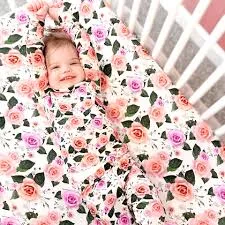
Breathability: Linen allows air to pass through easily, keeping kids cool in summer.
Durability: Linen is tough and can handle rough play.
Natural Look: Linen has a simple, airy style that feels timeless.
Downsides
Linen wrinkles easily, which may bother some parents. It can also feel a little rough at first, but it softens with each wash.
Best Uses
Summer dresses
Shorts and shirts
Light jackets for warm weather
Linen is ideal for beach trips, summer outings, or hot, humid days. It’s not an everyday fabric for everyone, but it’s a great addition to a child’s wardrobe for warm seasons.
Wool and Merino Wool: Warmth Without Itch
When you think of wool, you might picture itchy sweaters that kids hate wearing. But modern wool—especially merino wool—is a whole different story.
Why Merino Wool is Great
Softness: Merino wool fibers are much finer than regular wool, making them soft instead of scratchy.
Warm but Breathable: It insulates in cold weather but also allows airflow, so kids don’t overheat.
Moisture Control: Wool can absorb moisture while still feeling dry.
Natural Odor Resistance: Perfect for active kids.
Best Uses
Winter sweaters and cardigans.
Warm pajamas.
Base layers for skiing or winter sports.
Cozy hats, scarves, and mittens.
Downsides
Wool can be more expensive than cotton or synthetic fabrics. It also requires gentle washing to prevent shrinking. But for families in colder climates, merino wool is worth the investment for comfort and warmth.
Other Kid-Friendly Fabrics
Beyond the main fabrics, there are a few other options that can be good for kids:
Modal: Made from beech tree fibers, modal is extremely soft, smooth, and breathable. Great for underwear, pajamas, and soft tops.
Jersey Knit: A type of cotton knit that is stretchy, lightweight, and durable. Perfect for t-shirts and leggings.
Fleece: Warm and lightweight, fleece is good for jackets or blankets. Choose high-quality fleece to avoid overheating or static.
Fabrics to Avoid for Kids
Not all fabrics are good for children’s skin. Here are some to be cautious about:
Polyester: Durable and cheap, but not breathable. Can trap heat and sweat.
Nylon: Often used in sportswear but can cause overheating.
Acrylic: Feels like wool but traps heat and doesn’t breathe well.
Harshly Dyed Fabrics: Bright colors sometimes mean heavy chemicals. Always check labels.
These fabrics aren’t always harmful in small amounts (like rain jackets or costumes), but they shouldn’t make up most of your child’s wardrobe.
Practical Tips for Parents
Read Labels Carefully
Check fabric tags when shopping. Look for 100% cotton, organic cotton, bamboo, or merino wool. Certifications like GOTS (Global Organic Textile Standard) or OEKO-TEX ensure safety.
Feel the Fabric
Don’t just look—touch the fabric. Is it soft? Stretchy? Will it breathe? If it feels scratchy to you, it’ll feel even worse for your child.
Buy Fewer, Better Pieces
Instead of overloading your child’s closet, invest in a few high-quality outfits. Clothes that last longer and feel better are worth more than a pile of uncomfortable ones.
Wash Before Wearing
Always wash new clothes before your child wears them. This removes any leftover dyes or chemicals from production. Use gentle, fragrance-free detergent for sensitive skin.
Think About the Season
Choose fabrics based on weather. Cotton and bamboo for summer, wool and fleece for winter, and linen for hot, dry days.
Conclusion
Choosing the right fabric for your child’s clothes makes a huge difference in their daily comfort and health. Soft, breathable, and safe fabrics like cotton, organic cotton, bamboo, linen, and merino wool allow kids to move freely, stay comfortable, and avoid irritation.
Each fabric has its strengths: cotton for everyday wear, bamboo for hot climates, linen for summer, wool for winter, and organic cotton for peace of mind. By avoiding harsh synthetics and paying attention to labels, you can build a wardrobe that’s gentle on your child’s skin and kind to the planet.
At the end of the day, what matters most is that your child feels happy and comfortable in what they wear. Clothes aren’t just outfits—they’re part of how kids explore the world. And when they’re wrapped in soft, safe fabrics, they can focus on what really matters: playing, growing, and being kids.
More About Cotton: Everyday Tips for Parents
One of the best things about cotton is how easy it is to live with—but there are also some tricks to make the most of it. Parents often ask, “How do I keep cotton clothes looking fresh?” or “Why did my child’s cotton shirt shrink after washing?” Here are a few simple answers:
Pre-shrunk cotton is your friend. Look for labels that say “pre-shrunk.” This means the fabric has already gone through a wash process, so it’s less likely to shrink at home.
Wash in cool water. Cotton lasts longer and holds shape better when washed in cold or lukewarm water instead of hot.
Avoid heavy drying. Tumble dryers can shrink cotton. Air-drying is gentler, though it may take longer.
Spot clean when possible. Kids are messy, but you don’t always have to wash the entire outfit. A quick spot clean with mild soap can save the garment from fading due to over-washing.
For baby clothes, stick with 100% cotton, as blends can sometimes introduce synthetics that trap heat. For older kids, cotton blends with a small percentage of elastane or spandex can add stretch, which is great for play clothes.
Bamboo vs. Cotton: A Parent’s Dilemma
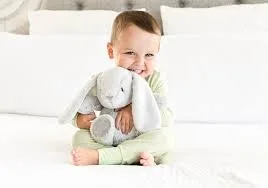
Parents often find themselves choosing between bamboo and cotton. Both are excellent, but they have different strengths:
Bamboo is cooler. If you live in a hot, humid climate, bamboo pajamas and onesies can make nighttime more comfortable.
Cotton is sturdier. Cotton can handle heavy washing and outdoor play. Bamboo, while soft, may wear out faster if used roughly.
Bamboo resists odor. This is especially useful if your child sweats a lot or has sensitive skin prone to irritation.
Cotton is budget-friendly. High-quality bamboo is often more expensive.
Some parents like to mix both fabrics in their child’s wardrobe—cotton for everyday wear and bamboo for sleepwear or special comfort clothes.
Wool Care: Keeping It Cozy
Many parents shy away from wool because they think it’s difficult to care for. But modern wool, especially merino, is much easier to maintain than most people think.
Gentle wash settings. Use the wool cycle on your washing machine, or hand wash in cool water.
Use wool-friendly detergent. Regular detergent can be harsh on wool fibers.
Air dry flat. Hanging wool clothes can stretch them out; laying them flat keeps their shape.
Store carefully. In off-season months, keep wool garments in a breathable bag to protect from moths.
Merino wool, in particular, doesn’t need to be washed as often as cotton. It resists odors, so you can often air it out between wears. This makes it practical, even for kids.
Linen in Real Life
Linen often gets labeled as a “fancy” fabric, but it can be surprisingly practical for kids in hot weather. Parents sometimes worry about wrinkles, but here’s the truth: those natural wrinkles are part of linen’s charm. A little crumple makes it look effortlessly stylish.
To make linen softer faster, wash it often. Each wash makes linen fibers relax. If your child complains that linen feels rough at first, don’t give up—after a few washes, it will feel much softer.
For toddlers and older kids, linen shorts and dresses are fantastic for summer vacations, especially near the beach. They dry quickly, they stay cool, and they don’t trap sweat.
Modal and Other Hidden Gems
We mentioned modal briefly, but it deserves a closer look. Modal is made from beech trees, and it has a silky feel that many parents describe as “buttery soft.” It’s more durable than cotton, holds color beautifully, and resists shrinking. For sensitive kids who dislike tags or seams, modal fabric feels almost weightless.
Another fabric worth noting is Tencel (Lyocell). Made from sustainably harvested wood pulp, Tencel is smooth, breathable, and eco-friendly. It’s similar to modal but often considered even more sustainable.
These fabrics are less common in kids’ wardrobes, but they’re gaining popularity among eco-conscious parents. Pajamas, leggings, and underwear made from modal or Tencel are a luxurious yet practical choice.
Fabrics to Avoid: A Closer Look
Polyester and nylon often sneak into children’s clothing because they’re cheap and durable. But they come with downsides:
They don’t breathe well, leading to sweaty discomfort.
They can cause rashes in sensitive kids.
They hold onto odors, making clothes smell less fresh.
However, not all synthetics are “bad.” A small blend of polyester with cotton can sometimes make clothes more durable without losing comfort. The key is balance. Aim for fabrics that are at least 70–80% natural fibers for everyday wear.
FAQ: Parents’ Most Common Fabric Questions
1. Is polyester always bad for kids?
Not always. A small amount in blends can make clothes more durable and easier to wash. But avoid 100% polyester outfits for everyday wear, especially in hot weather.
2. Do I really need organic cotton?
If your child has sensitive skin, allergies, or eczema, organic cotton can make a big difference. If not, regular cotton is still a safe and affordable option.
3. Can I mix fabrics in my child’s wardrobe?
Absolutely! Most parents do. The key is choosing natural fabrics for items that touch the skin directly (like underwear, pajamas, and t-shirts). Outerwear can be more flexible.
4. How many outfits does a baby need?
Babies often need more than you think because of spills and diaper accidents. Around 7–10 cotton onesies, a few bamboo sleepwear pieces, and some seasonal layers like wool sweaters or linen dresses are usually enough.
5. Are fleece pajamas safe for kids?
Fleece can be warm and cozy, but it’s not very breathable. It’s better for cold climates and older kids rather than newborns. Always make sure fleece sleepwear follows safety standards.
The Future of Kids’ Fabrics
The world of textiles is changing fast. Parents today not only want safe fabrics for their kids but also sustainable ones. Here are a few trends to watch:
Recycled fabrics: Some brands are making kids’ clothes from recycled cotton or polyester, reducing waste.
Plant-based innovations: Fabrics made from banana fibers, hemp, and even pineapple leaves are being explored as sustainable options.
Smart fabrics: In the future, fabrics might regulate temperature automatically or resist stains without chemicals.
Eco certifications: Expect to see more clothing labeled with sustainability badges, making it easier for parents to make informed choices.
This shift means that in just a few years, your child’s wardrobe could look very different—lighter on the planet and safer for their skin.
Final Thoughts (Extended)
When you’re standing in a store or scrolling online, it can feel overwhelming to choose fabrics for your child. But remember this: keep it simple. Stick to the basics like cotton, bamboo, linen, and merino wool. Add in some organic or modal pieces if you like. Avoid harsh synthetics for everyday wear.
At the end of the day, it’s not about having the trendiest outfit—it’s about your child feeling good in their clothes. Clothes should never distract from play, sleep, or cuddles. They should support all of that.
So next time you buy a onesie or a school shirt, think less about the cartoon character on the front and more about the fabric touching your child’s skin. That’s what really matters. And when you choose well, you’re not just buying clothes—you’re giving your child the gift of comfort, health, and confidence.
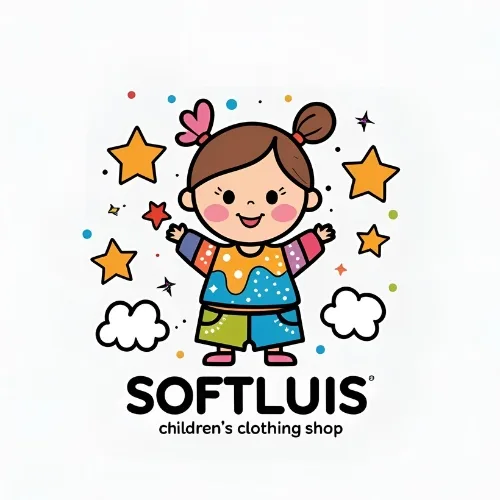
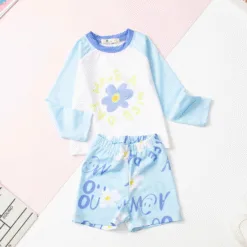 Children's swimwear - SW01 2/12 BG long sleeve
Children's swimwear - SW01 2/12 BG long sleeve 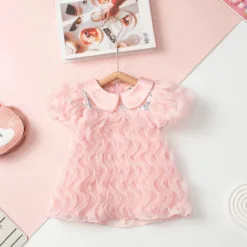 Newborn chiffon dress 6m/36m
Newborn chiffon dress 6m/36m 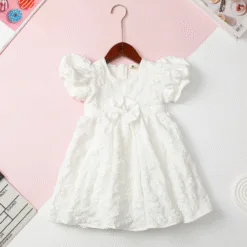 Puffy newborn dress 6/36month
Puffy newborn dress 6/36month 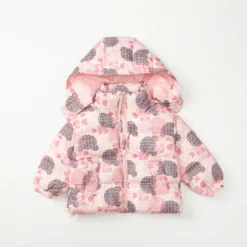 Boys and girls cotton down jacket, size 2/10 years old
Boys and girls cotton down jacket, size 2/10 years old 